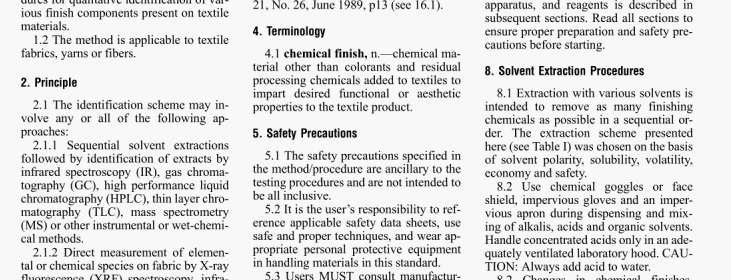Test Method for Finishes in Textiles

AATCC 94-2020 pdf free.Test Method for Finishes in Textiles: Identification.
Infrared spectroscopy offers a convenient way to identify extracted finish from textiles. The basis for infrared spectroscopy is the structural information about a compound that can be found from its infrared spectrum. Infrared absorption bands in the 4000 to 250 wavenumbers region result from specific functional groups in a molecule. These can be compared with spectra of finishes in published or personal libraries. Visual inspection by a trained analyst will quickly identit’ the general type of finish. Coinputenzed search-and-match capabilities on many infrared systems will be helpful. For more complctc information, including typical wavenumbers for comparison of spectra of textile materials, descriptions of ncwcr techniques such as Fourier transform infrared spectroscopy (FTIR), attenuated total reflectance spectroscopy (ATR) and primary references, refer to Analytical Methoth fin- a Tettile Luhorutory (see 3.2). For representative spectra of chemical finishes, refer to Infrared Spectra for the Idenrification of Chemical Finishing Agents from lèrvikc (see 3.3).
FTIR spectrometers arc capable of producing high quality spectra for identilication and reference purposes. Other spcctroscopic techniques such as laserRaman spectroscopy, mass spectrometry and UV-Visible spectroscopy may also be utilized, if available, to further identif’ the extracts. Figs. 1-6 represent infrared spectra run on an FTIR spectrometer at a resolution of 4 wavcnumbcrs of a fatty ester softener, a silicone softener, a dimethyldihydroxyimidazolidinonc (DMDHI. aka DMUG) cellulose reactant, a glycolated dimethyloldihydroxyethylene-urea (DMDI-IEU) cellulose reactant, a telrakis-(hydrnxymcthyl)phosphonium
chloride (or sultte) flame retardant and a
C-6 Iluorochemical oilwatcr repellent. respectively. Fig. 7 represents a lascr-Raman spectruni of an aqueous solution of a DMDHEU cellulose reactant using an argon ion bser source.
Techniques. Prepare finish sam- pies for infrared analysis by dissolving the extract in suitable solvent for analysis as a liquid or as a east film on an ATR crystal.
Infrared Analysis.
Obtain a spectrum of the sample or extract prepared by one of the above techniques. Compare the sample spectrum with infrared spectra of known finishes. For laboratories that possess an FTIR instrument. it is strongly recommended that an in-house spectral libraiy of appropriate finishing agents be developed. For more accurate identification. the spectrum of the known compound should 1w obtained with the same application and extraction history as the unknown finish.
9.4.2 Sofleners. Quaternary ammoniuin compounds, polyethy lenes, polyoxyethylenc glycols. polyurcthancs. polyaerviates and silicones are soluble or partially soluble in hot hexanes. (‘oricenIrate the extract and transfer to a clean ATR crystal.
9.4.3 Durable Press Reactants. Since most durable press reactants for cellulose can be extracted with either water or hydrochloric acid, this provides an alternate method for removing finishes for infrared spectroscopy.
Use chemical goggles or face shield, impervious gloves and an impervious apron during dispensing and mixing of alkalis, acids and organic solvents. handIe concentrated acids only in an adequately ventilated laboratory hood. CAUTION: Always add acid to water.
Rdflux approximately 0.2 g fabric, cut into small squares, for 5 mm in 0.1 N HCI. Carry out reflux procedure in a well-ventilated hood with an electrical heater or a water bath as the heating source. Use chemical goggles or face shield, impervious gloves and an impervious apron when handling organic solvents.
Decant the solution into a 50-mL round-bottom flask with 350 mg spectral grade KBr.
Evaporate to dryness on a rotary evaporator while the flask is immersed in an icc-salt bath to prevent further hydrolysis.
Complete final drying over phosphorus pentoxide.
Mix the residue with more KlIr (in a 50 mg:300 mg ratio) and press into a disk.AATCC 94 pdf download.Test Method for Finishes in Textiles